I saw a lot of ads on Netflix for Extraordinary Attorney Woo and it looked cute, so I decided to watch it. I had no idea that it was one of a whole genre, and that my Netflix would be flooded with “If you liked Extraordinary Attorney Woo, you’ll love Crash Landing on You and “If you liked Crash Landing on You, you’ll love King the Land." Five months later, I’m almost fluent in Korean and I’m handmaking 라면—lamyeon—ramen. Next I’ll be making green onion kimchi, beating my husband with my wooden spoon and giving my friends vitamin regimens for their birthdays.
Convinced that I was Japanese in a previous life, I’ve been obsessed with Asia since I was a tiny girl, when people still called it “the Orient” and thought it was all behind a “bamboo curtain.” I’ve been to Japan multiple times and studied Japanese in university, but the closest I’ve ever been to Korea is Koreatown in Osaka where I shopped and ate lots of side dishes with long metal chopsticks, so I had a lot to learn.
Here is what I’ve learned about Korea from K-dramas:
Eighty pound young women eat forty pounds of food at a meal. Their boyfriend thinks it’s adorable.
Shoes seems to have some special meaning, and they are often woven into the story. A guy is either buying her shoes, cleaning her shoes, repairing her shoes, finding her lost shoes or straightening them at the door. Every time shoes have been involved they were part of a sigh-worthy romantic gesture.
Koreans are a violent people. Violence in the home, school and workplace is prevalent. I had to look it up, because I didn’t want to believe it, but it’s true. Workplace violence where superiors thump the foreheads of employees who made a mistake or they bop them on the head still happens, although there are laws against it. The violence depicted in the home is awful, and I can’t figure out if it’s meant to be comical, but it turns my stomach. One mother soundly beat anywhere she could reach on her grown daughter with a bamboo back scratcher. There were visible injuries. Older siblings beat the younger, teachers beat students, students beat each other, grandmas beat grandsons. In fact, old ladies beat about anyone who annoys them in anyway with whatever object they can get their hands on.
Every injury, no matter how trivial, is treated at the hospital with an IV. There is never a wait and their doctor/nurse to patient ratio seems to be about ten to one.
Fat people are used as comic relief. If one is fat, they are funny. Period. Bonus points for having big teeth.
Every village or neighborhood has a group of coarse, frumpy, and tacky, middle-aged to elderly women whose purpose is to play Greek chorus. They are always busy with their hands making community kimchee or shelling beans, and they have a cruel or snarky comment about everyone who walks by. If no one walks by, they turn on each other like piranha.
I love how death and grief are depicted. The United States does bereavement badly. We get to grieve through the funeral, but quietly and orderly, with no hint of a scene of any kind, and by the time the funeral dinner comes along, we are supposed to be up to shallow conversations and joking around. Koreans are allowed, no, expected to grieve and to do so heartily. There are strict formalities, all that have the purpose of honoring the dead, but even with all of the formality, the family and other loved ones are depicted falling to the floor, wailing and keening. Yes. that is grief, when you don’t have to hide it. I also like that once a year they have a ceremony in the home to visit with, remember and honor their loved one. There are flowers and all the favorite foods and drinks, along with a pretty picture, which I learned are taken just for this purpose. I also like that they believe their loved one is not gone from them and they talk to them, fully believing that they are heard and helped by their grandma who still loves them. That’s lovely.
Virginity, although not discussed, seems to be highly valued, and apparently it can be reborn. There are scenes where a forty-three old divorced woman is with the male lead and, when he goes to hold her hand, she’s as shy and coy as a thirteen-year-old about it. She glances down and her eyelashes fan out on her flushed cheeks. She peeks up from under her bangs to look at him, then gasps and looks away as his fingers lock around hers. By the time she regains her composure, her inner voice, which we can hear, is making wedding plans.
Grown-up people obey their parents. That deal expires at 18 in our culture.
Close-knit friend groups of men and super close-knit friend groups of women are common. I think in the US, singles hang out more in mixed groups. It feels a little ridiculous, though, to watch a dozen thirty-something men laughing and drinking together while asking “Do you like Kim Ji-woo?”
One of my favorite tricks is when a plot is full of backstory coincidences. “I’ve seen you before, you know,” he says. “You were standing on a bridge looking like you wanted life to be over. I had picked a flower to give to my little sister, but decided to hand it to you.” “You were that man? You saved my life that day.” Or the man looks at a picture on a desk of a father and little girl at the beach. He smiles and exclaims, “I took that picture! I was only a about five and we were on vacation. Your father asked if I could work the phone, and I did it.” A young executive tells his girl about the day he almost gave up on school. He’d gotten in trouble for something another boy did and was discouraged and feeling sorry for himself. When he went to his desk for detention, someone had placed a candy bar on it. His secretary confesses that she’s the one who did it. He had never once even noticed her in school, but she was in love with him the whole time. Sigh. Sniffle, sniffle.
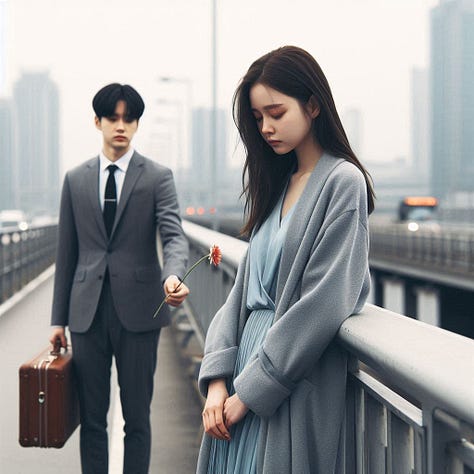

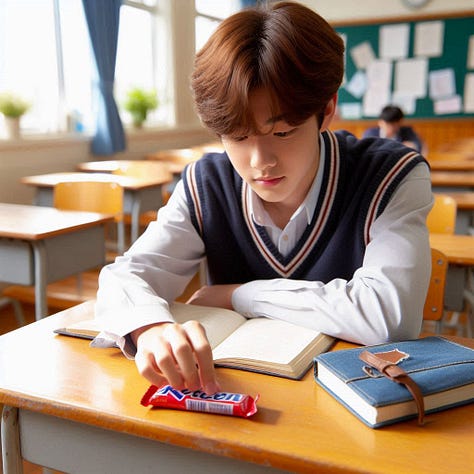
Product placement is out of control and truly laughable. There have been so many times I’m laughed out loud and wonder how a serious actor could force themselves to do it. In a romantic moment together, a woman will say, “I’m sleepy,” and he’ll hand her a package with “Kopico” clearly visible and say, “Try a Kopico! It will wake you up!” She takes the candy and places it daintily into her mouth and says, “Mmmmm. Tasty!” Every girl has a makeup table and it is covered with brand-named cosmetics. They give each other gifts of vitamin regimens in huge gift boxes declaring “Jung Kwan Jang’s Ginseng-based Supplements.” An elegant man, head of a company, will finish his dressing by opening a cabinet where he chooses his accessory from several designer watches resting in their leather cases while the camera zooms in on the names. It’s hilarious.
When one is lying on the floor dying, the first responders burst through the kitchen door with a stretcher and pause to take their shoes off before saving your life. Life is important, but manners are manners.
In these romances, the hero often wins the heart of his lady with small, thoughtful courtesies instead of grand romantic gestures. By doing so, he is saying, “I see you,” and it gives me palpitations. She will find him behind her with a flashlight if it’s dark on her path or he’ll suddenly appear in a busy Seoul crosswalk with a brightly colored umbrella to hold over her. She’ll shiver while reading and he’ll rush over with a blanket and cover her tenderly. She’ll sneeze and he’ll make soup. If she gets drunk, he’ll modestly put her to bed, tuck her in, leave a glass of water and hangover medicine (they seem to have such a thing) on the bedside table and a pot of hangover soup simmering on the stove on his way out the door. I find myself sighing audibly.
Studying is serious business for even the youngest of children, but by the teen years, the pressure is harsh and not sustainable for many. Many children and young people crash from it and the suicide rates are high. There doesn’t seem to be an expectation that not everyone is cut out for university and a profession. Of the vocations people might have toward plumbing, mechanics, carpentry, electrical, and other trades, only chef seems to be even remotely acceptable. But you have to be a “starred chef.”
There seems to be a set protocols for establishing a relationship:
First the boy and girl pretend they hate each other for nine of the 18 episodes.
Next, they decide they only have nine episodes left, so one of them looks the other in the eye and blurts out what they call a confession, “I like you!” with all the fervor of a melodrama. Never have such benign words carried such weight. This means that they can now hold hands.
After liking each other for a period of time, they think they should cement the deal and make it exclusive, so one of them will ask, “Are we dating?” while holding hands at a movie theater as the film plays. Seeing all the signs of it, they agree that they are. It is in this stage that they refer to each other as boyfriend and girlfriend and they call their loved one’s family Mother, Father, Sister, etc. This is to soften the family up for what happens next.
What happens next is they say, “I love you,” meaning that they can now sleep together, but it’s done so discreetly that if it was consummated we never know for sure. I think it is inferred by the giggling over morning coffee.
Next, they decide to tell their parents they’re getting married. The parents will vehemently forbid it, of course. They will say the “kids” don’t know each other well enough or, being neighbors their entire lives, they know each other too well. One of them will have a shaky family tree. The social scale will be off balance, greatly favoring one of the families. If one of them has a child from a previous marriage, even if that one is widowed, they treat the situation like the nastiest thing that ever existed, while showering the orphan with love and attention.
The parents finally give in, deciding that their nearly 50 year-old-children might be old enough to decide such things themselves. Then they pay about a million dollars for the wedding.
I like the way they do weddings. They are mostly held in wedding venues in business buildings, so everything is very convenient and perfect. The thing I like the most is that guests sit at tables on either side of a long runway. This is where they eat, drink and enjoy the wedding. It’s like the reception and wedding are one event and there’s not all that moving from place to place and waiting for food service or photos. Many very formal shots are taken in the weeks before the wedding and then group photos are taken after the dinner and everyone can watch. There is an emcee, usually one of the groom’s nerdiest friends. He announces the cast of characters as they walk down the aisle with great flourish. The groom sometimes dances down the aisle energetically in a showy way, maybe even doing a cartwheel. The bride comes down more sedately and with decorum. Now, where can I find a Korean wedding in Portugal?
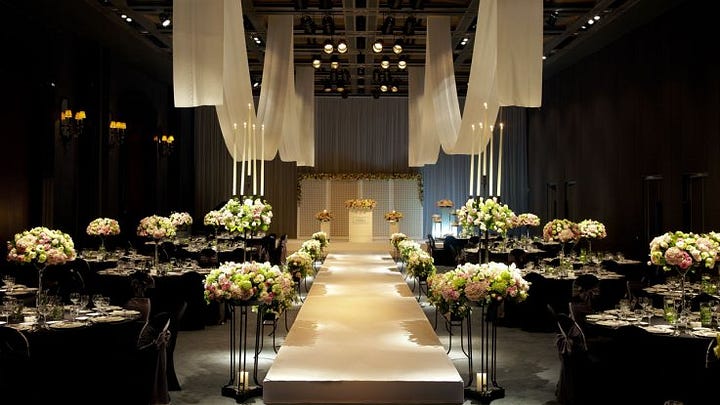
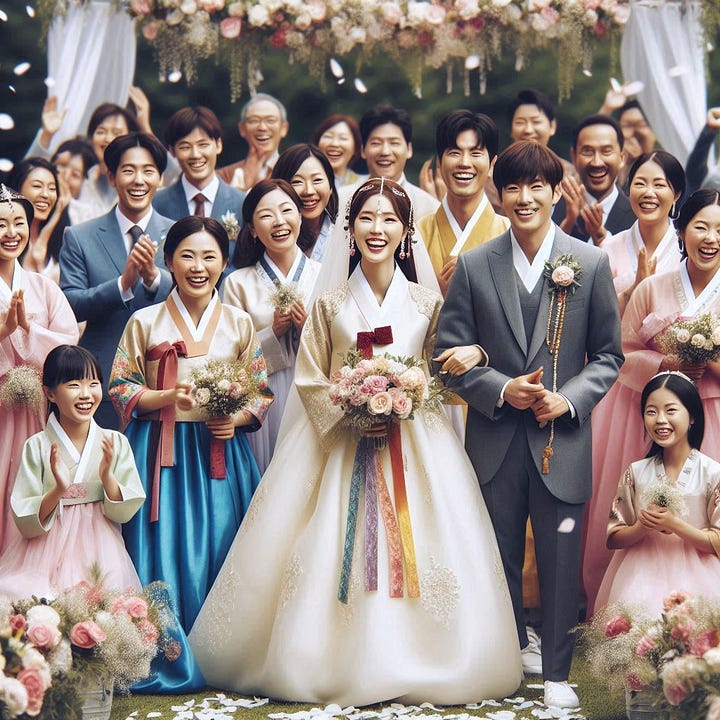
The women of Korea are shown as sturdy, strong and hardworking. They are working during every waking hour, either doing household chores, diving for seafood in Jehu, filling huge vats with food to ferment, minding the children, doing laundry, running a store or a small restaurant and cooking, always cooking. The husband is seldom depicted as helping in any way and the children are encouraged to work on their studies and not worry about household chores. Of course the very wealthy have servants.
That weird noise they make in their throat. When wanting to emphasize something or to express rage, they make a raspy gutteral noise in the back of their throats that sounds like a live baby squid has attached itself to the uvula. This sound is like fingernails on a chalkboard for me, and many of the older people or comics do it constantly. Seems like one could easily get nodes on the vocal cords with this habit. The sooner, the better.
Side dishes. Nothing unusual about that, right? We have side dishes. Some mashed potatoes and peas and, on a festive occasions, perhaps a salad. Side dishes are at a whole different level in Korea. The main dish, let’s say fish, is completely surrounded by tiny plates of this and that and the other, always to include kimchi. With much palaver, the mother seems to make these once a week in great quantities. She fills Tupperware containers with them and takes them to her grown children who live alone, her married children where the wife works or is lazy or inept, the grandparents, aunties, etc. Sometimes, the young people, whose fridges are full of beer, whine, “Maaa ah ah ah! Stop bringing me these side dishes! I never eat at home.” I suspect they can become like fruitcake where people just pass them on to each other.
Speaking of a lot of food, I can’t let this go before I mention table manners. I am used to Japan where, although noodles are slurped to cool them, the other table manners are exemplary. They do not point with their small, dainty chopsticks, nor bang the tips of them on the table to even them out. I have a special aversion to eating noises, to the point that I can contemplate murder while being forced to listen to them. Korean eating seems to be some kind of free for all for starving people. They hold metal clanking chopsticks in one hand and a long-handled metal spoon with the other and they shove gigantic bites of food into their mouths with both implements simultaneously. And the size of those bites! Oh. Maybe that’s why they make that throat noise when they talk; there is food from last week still stuck back there.

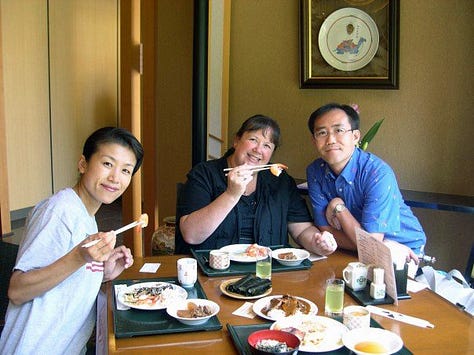
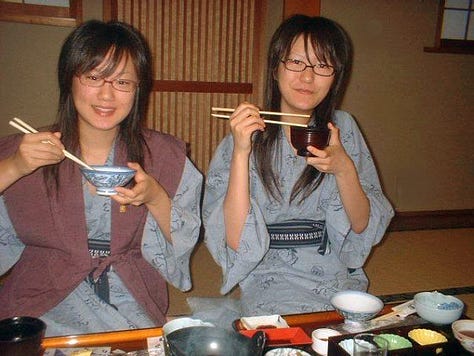
The power of the super rich is amazing. It’s as if they’re a whole different magnitude of human. Levels of hierarchy are strictly observed, with those on the very top receiving deference worthy of a king. This includes members of the boss’s own family: parents, siblings, wife and children. They control the minutiae of their business and the personal lives of their family. They wield their power without mercy. They are some scary folk, especially the women. I get the chills when one of them seems to look through the TV and fix her haughty gaze on me. They are never happy or content and no one loves them. It’s a morality tale against being rich. Whew! Bit the bullet on that one!
The last word: Endings. I am not happy with 2/3 of the endings. When one has travailed with a couple through their first awkward flirtations and the will-they-or-won’t-they hand holdings, ups and downs and beatings and challenges and woeful drunkenness for 20-40 hours of programming, one wants a happy ending. Period. And by happy ending, I mean a full on Korean wedding where even the ancestors dance.
However, what are they giving us? The ambiguous ending, the inspiring ending or the back-to-the-future ending. In the ambiguous ending, they each move to separate cities, countries or planets to follow their dreams, but their love for each other will never change. Sure it won’t. In the inspiring ending, the woman, not wanting marriage and children, goes off alone into the sunset to follow her dreams, but with a wistful backward glance and voice-over hinting of a reunion in the future. Bah! In the back-to-the-future ending, they first subject us to an ambiguous or inspiring ending and then try to placate us with a back-to-the-future postlude. In this ending, the couple are middle aged, and their son is a newscaster or sports hero with an adoring wife and a very bright child. They snuggle on the sofa eating persimmons and proudly watch him on TV. This is the worst ending of all because, clearly, they robbed us of the true happy ending: the wedding. So, writers of K-Drama, no one wants your clever and correct endings. When you spend 40 hours getting us all worked up, we want to finish with a happy ending!











This is great. Our daughter-in-law is Korean and we participated in the wedding in Seoul. We had no idea what we were meant to be doing as women fussed over us changing our corsages at seemingly random times and then giving us nuts and dates to toss on a cloth…there were acrobats and a wooden goose…it was stunning.
You’ve captured so much of what we observed over the years…
Mr. Sunshine has all that drama, with 3 guys chasing the girl. It might be my favorite. Also, it’s possible to tour the series set near Seoul, Korea. It’s surprisingly small, withe the various buildings very near each other. The “hotel” in the series has some food service inside. Enjoy a tea and pretend to live 100 years ago.